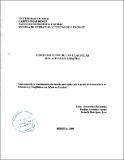| dc.contributor.advisor | Villalobos Gamboa, María Eugenia | |
| dc.contributor.author | Hernández Hernández, Luisa | |
| dc.contributor.author | Alvarado Vargas, Paulina | |
| dc.contributor.author | Rodríguez Arce, Guiselle | |
| dc.date.accessioned | 2020-06-03T05:35:18Z | |
| dc.date.available | 2020-06-03T05:35:18Z | |
| dc.date.issued | 2000 | |
| dc.identifier.uri | http://hdl.handle.net/11056/17495 | |
| dc.description.abstract | Demuestra que el “que” introductor de las cls. rels. no es un pronombre relativo sino un subordinante carente de significado, según las teorías de Liga Rección de Chomsky y Casos de Cook. Expone que en la mayoría de los pronombres relativos “quien”, “(el)”, cual”, cuy (o) y sus plurales, pueden alternar su posición con el subordinante “que”. Además, determina en términos porcentuales, el tipo de relativización que predomina en el discurso narrativo en el español. Entre sus objetivos específicos están: demostrar, según la teoría de Comrie, que el español, en su formación de cls. rels., pertenece a los tipos 3 y 4: pronombre relativo y vacío, respectivamente. Investigar, por medio del análisis, qué roles semánticos desempeñan los pronombres relativos y el introductor de cláusulas relativas “que”, por otra parte, pretende demostrar que la mayoría de cls. rls. del español en su estructura interna son vacías, por no ir encabezadas por un pronombre, sino por el subordinante “que”. Es una investigación de carácter descriptiva, con enfoque cualitativo, que desarrolla tres análisis: sintáctico, semántico y discursivo. Entre las conclusiones que se presenta en este trabajo, es que se afirma que la estructura sintáctica interna de las cls. rels. en español puede ser de dos tipos: la introducida por el mercado de clausula “que” y la que presenta un pronombre relativo y carece de ese marcador. Esta última excepto la introducida “como”, puede alternar con la del tipo de ausencia de núcleo. | es_ES |
| dc.description.abstract | It shows that the "what" introducer of cls. relays. it is not a relative pronoun but a meaningless subordinate, according to the theories of Chomsky's Rection League and Cook's Cases. Exposes that in most of the relative pronouns "who", "(the)", which ", cuy (or) and their plurals, they can alternate their position with the subordinate" that ". Furthermore, it determines, in percentage terms, the type of relativization that predominates in narrative discourse in Spanish. Among its specific objectives are: to demonstrate, according to Comrie's theory, that the Spaniard, in his formation of cls. rels., belongs to types 3 and 4: relative pronoun and empty, respectively. Investigate, through analysis, what semantic roles relative pronouns play and the introducer of relative clauses "that", on the other hand, aims to demonstrate that most of cls. rls. Spanish in their internal structure are empty, not being headed by a pronoun, but by the subordinate "what". It is a descriptive research, with a qualitative approach, which develops three analyzes: syntactic, semantic and discursive. Among the conclusions presented in this work, it is stated that the internal syntactic structure of the cls. relays. In Spanish it can be of two types: the one introduced by the market clause “que” and the one that presents a relative pronoun and lacks that marker. The latter, except the one entered “as”, can alternate with the type of absence of nucleus. | es_ES |
| dc.description.sponsorship | Universidad Nacional, Costa Rica | es_ES |
| dc.language.iso | spa | es_ES |
| dc.publisher | Universidad Nacional, Costa Rica | es_ES |
| dc.rights | Acceso abierto | es_ES |
| dc.rights | Attribution-NonCommercial-NoDerivatives 4.0 Internacional | * |
| dc.rights.uri | http://creativecommons.org/licenses/by-nc-nd/4.0/ | * |
| dc.subject | ESPAÑOL | es_ES |
| dc.subject | GRAMÁTICA | es_ES |
| dc.subject | SINTAXIS | es_ES |
| dc.subject | GRAMMAR | es_ES |
| dc.subject | SPANISH | es_ES |
| dc.subject | SYNTAX | es_ES |
| dc.title | Conformación de las cláusulas relativas en español | es_ES |
| dc.type | http://purl.org/coar/resource_type/c_7a1f | es_ES |
| una.tesis.numero | 4085 | es_ES |
| dc.description.procedence | Escuela de Literatura y Ciencias del Lenguaje | es_ES |


